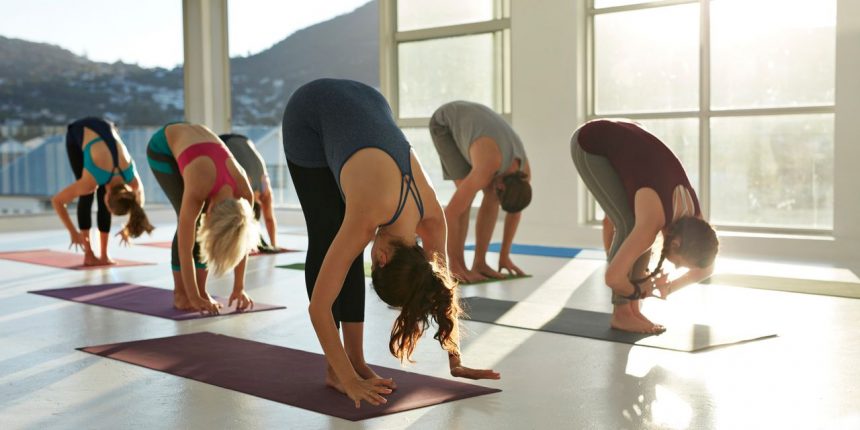Yoga studios are largely a “you do you” kind of space. Still, if you talk to instructors, there are a few little things that students do in class that…they’d maybe wish they didn’t. Some of these habits could put you at risk of hurting yourself. Some can mess with other students’ class experience. And others just mean you’re not getting as much out of your flow as you could.
We tapped a handful of longtime yoga instructors to hear about the most common faux pas they see in the studio. No, we’re not here to shame anybody for not doing yoga “perfectly”—since that’s not possible, or even the point. The goal is simply to help you approach the mat in the most effective way you can so that you’re able to soak up everything a good flow has to offer.
1. You try to force poses into what you think they should look like.
In most fitness classes, students are asked to basically match what the instructor’s doing while everyone works toward goals like lifting heavier weights or doing more reps. So it’s easy to see why people mistakenly bring this same mindset into the yoga studio. But yoga should really be about tuning into your own body. How a pose feels is far more important than how a pose looks. “All of our bodies are made beautifully different, and what works and feels good and is the right thing for you is probably different from your neighbor or me,” registered yoga teacher Rachel Hirsch, founder of Los Angeles’s Empowered Yoga Studio and cohost of The Femme Portfolio podcast, tells SELF.
When people push themselves into an asana, or pose, in a way that’s not right for their body, they can stretch tissues that aren’t prepared for that range of motion and end up injured. It also undercuts the purpose of yoga, Seattle-based registered yoga instructor and teacher trainer Elena Cheung tells SELF. “The point of the practice is about connecting to ourselves and looking inward and transcending some of these less-helpful aesthetic priorities,” she says.
What to do instead: Embrace wherever your fitness levels and energy are at each time you step onto the mat, rather than focusing on how you measure up against the person next to you (or even your own past abilities). “What’s important is to really be with where you are in the present and not compare yourself,” registered yoga instructor Paris Alexandra, founder of The Brooklyn Wellness Club, tells SELF. She recommends using yoga class to show yourself kindness and zero in on your individual experience even though you’re in a collective space. Pro tip: If you’re naturally a competitive person, it can be helpful to attend a studio without a mirror, or at least set yourself up somewhere in the room where you’re not tempted to stare at your reflection.
2. You do other things during Savasana—or take off early.
It’s easy to write off Savasana, the restorative posture at the end of class where you simply lie on your back. “The physical exertion is what people generally are looking for,” registered yoga teacher Michelle Salvatore, vice president of yoga and operations at CorePower Yoga, tells SELF. “And people feel uncomfortable sitting in that stillness.” So sometimes students roll up their mat to head out of the door during this final pose, or do ab work or headstands instead. But this habit means you’re not only missing out on Savasana’s benefits yourself, you’re potentially ruining this powerful meditative moment for the people around you.
“Savasana is one of the more sacred aspects of the practice,” Cheung says. “It’s the time when everyone gets to really integrate the work of what they’ve done. It’s the moment of stillness that the arc of the class is working up toward.” Although you might think you’re being quiet, the extra shuffling around (and rushed energy) can make it hard for other students to fully relax.
What to do instead: Ideally, it’s best to stay until the end of class and challenge yourself to simply be still. Remember: “It’s literally two to three minutes of your life,” Alexandra says. “Give yourself the space to just relax.” If you absolutely need to skip out early, do it well before Savasana so that you’re out of the room by the time everyone else settles into the pose, Cheung suggests. And save the headstands and core exercises until after class is over (more on that, below).
3. Your phone becomes a main character in your practice.
We get it: It can be super tempting to peek at your phone between sun salutations. But this interrupts the mindful escape that yoga can offer. Some instructors like Hirsch even ask students to leave their phones outside the studio altogether, and yet they still encounter this problem. “There are some people that will go out every little bit and check their phone,” she says.
Hirsch appreciates that our phones can be addictive. “But that is something that you should be working on in your yoga practice—how long can I feel safe and not jittery without checking my phone?” she says.
Other students use their phones to record class. Which isn’t necessarily a bad thing. “But sometimes there are other people in the background,” Cheung says. Not asking for consent from others in the shot—or the teacher—can make them uncomfortable and disrupts the “sanctity of other people’s practices,” she says.
What to do instead: Try to use class as a time to unplug. If you absolutely need your phone next to you for emergencies, turn it on silent, and configure the settings to limit vibrating notifications to only those that are absolutely necessary.
Also, it’s best to film content outside of class so you don’t make other students uncomfortable. But if you really want to capture the class itself, Cheung suggests first asking the instructor for their permission. Then set up in a corner where you’re not getting other students in the frame.
“People like to share their practice on social media—we love that,” Salvatore says. “Though respect that everyone is there for their own journey, and what you need out of it when you step onto your mat is different than what someone else needs and the exposure that they want.”
4. You wear clothing that works against you.
As much as we love a cute matching set, there’s truly no “right” outfit to wear for yoga. (Cheung says she’ll often do a flow in her pj’s or show up to studio classes in sweatpants.) Yet certain clothing choices can hold you back. The most common wardrobe mistake is wearing socks, which can leave you slipping and sliding on your mat. “It changes your entire practice, your ability to do so many things,” Hirsch says. Meanwhile, pants that are too stiff or heavy can stifle your movement. And ill-fitting attire like a too-small top might mean you have to keep coming out of the pose to adjust the fabric—which doesn’t help anyone get into a “flow” state.
What to do instead: Prioritize what feels good to move in (and maybe give any new apparel a test run to make sure you’re able to fully stretch out in it before you get to class). “You don’t have to buy the super expensive pants,” Cheung says. “Just make sure you’re dressing to feel comfortable.” Or as Alexandra puts it, “Wear whatever makes you feel good in your body.”
If hygiene concerns make you nervous about going barefoot, consider bringing your own mat or wiping down one you borrow from the studio before you start, Cheung recommends. Or consider grippy socks that will give you more traction—some even allow your toes to poke out.
5. You ignore breath cues.
There’s a lot to think about in a yoga class. So it’s easy to let the breath fall by the wayside and ignore the teacher’s cues about inhales and exhales, especially when a flow gets challenging. But, Hirsch says, “When it gets really intense, that’s when you need [it] to keep going.” If you can learn how to breathe through harder poses in yoga, she says, you can better prepare for stressful situations in life, where harnessing your breath could help calm your nervous system.
Plus, holding your breath only ends up making things extra hard. “Our breathing mechanics can really set the stage for how we feel in our bodies and in our brains,” Cheung says.
What to do instead: If you notice you’ve lost control of your breath, Cheung suggests taking a beat. Try a gentler modification or go into child’s pose until you’re able to regulate your breathing.
You can also set proper breathing as your intention for class. “That will keep it top of mind,” Hirsch says. “And when your brain starts to wander, you come back to your intention and your focus on your breath.”
6. You avoid props or modifications.
It’s too easy to fall into the trap of thinking of props and modifications as crutches. But the reality is that these tools can actually make your flow far more powerful. “The prop is there to help enhance the asana so that you can progress to a deeper version of it,” Salvatore says. Hirsch, for instance, says she uses blocks to deepen her lunges. Other times she’ll choose to do a twist from her knees rather than a lunge so she doesn’t overstress her muscles before or after a big strength-training day.
Cheung points out that if your ego keeps you from taking advantage of props or variations, you can hurt yourself. It can also sabotage your practice. ”We get so lost in the physical challenge, it can interrupt our connection with the breath and our mind and our body and our spirit,” Cheung says.
What to do instead: Ask yourself what’s going to give you the most effective version of the pose that day. And remember that taking a different variation is just another option, Hirsch says. “It doesn’t mean that it’s less hard or less good or less challenging.” Maybe one day you feel strong and powerful by fully extending your torso in upward dog, while the next you want to zero in on the biceps and triceps challenge of cobra pose. “Acknowledge the changes, the ebbs and flows of our bodies,” Alexandra says. This is what makes yoga sustainable as a long-term practice throughout our lives.
7. You go rogue with your poses.
Yes, many poses are meant to be scaled up or down. But when you pull out a fancy upside-down inversion or arm balance that’s wildly disconnected from what the rest of the class is doing, you’re disrespecting the teacher’s intentions, and could distract students around you. “That really bothers me as a teacher when it feels less about adapting the practice for you and more about, How can I show off this handstand in the middle of class?” Cheung says. Result: It can seriously disrupt the energy of the room.
What to do instead: Many teachers offer a couple of minutes for “yogi’s choice” at the end of class before settling into Savasana. This is your moment to try any skills you’re interested in working on, Cheung says. If you never get that opportunity, consider seeking out a different class that might be a better fit for what you’re interested in, she adds.
You can also take advantage of transition times between classes. “Chat with the teacher either before or after class,” Hirsch suggests. A good instructor will then give you one-on-one feedback if the pose does come up during class, or at least suggest exercises to work on in your own time.
8. You always hide in the back—or hog the front.
It’s pretty common to have a go-to spot in the room when we hit up the same class regularly. “Maybe you go to the back or go to the front,” Alexandra says. Although there isn’t necessarily anything wrong with that, it can be a missed opportunity.
Many of us assume that when we’re in the front, all eyes are on us. However, “I really think most people are only thinking about themselves,” Alexandra says. But even just the thought of being in other people’s field of vision can affect your approach—and it can be good for you. “If you’re like, ‘You know what? Today, I’m going to go in the front and I’m going to commit to not being perfect, but I’m showing up,’ that is going to translate into any area in your life where you are challenged,” she says.
What to do instead: Switch up your place in the studio. “Showing up on the front could be an opportunity to take up space,” Alexandra says. “And then also, some people who are always in the front, they have an opportunity to give space to someone else to step into that.” She suggests finding a balance, and questioning whether your comfort zone is serving you. “It’s just an invitation to try new things—and not to be in comparison,” she says.
If any of these habits seem all too familiar, know that they simply represent an area to grow.
There’s a reason yogis call it a “practice.” The point isn’t to be perfect, but to embrace where you are even as you work to become stronger and more flexible (both physically and mentally). Learning about habits that may be holding you back is simply part of the journey. “Don’t beat yourself up about it,” Cheung says.
Although it might surprise some to hear it, Salvatore actually encourages students not to take yoga so seriously: “It’s okay to laugh!” Similarly, Alexandra also suggests not overthinking your yoga experience. “Just show up and fall out of the pose and get back up and take a break, go into child’s pose, drink some water, maybe go to the bathroom if you need to, and come back to it,” she says. “And as you continue to come back, as you are, you’ll continue to grow.”
Related:
- 6 Common Habits Podiatrists Say Are Wrecking Your Feet
- This 30-Second Stretch Makes Tight Hips a Lot Less Cranky
- 6 Small, Everyday Things Physical Therapists Wish You’d Stop Doing
Get more of SELF’s great fitness coverage delivered right to your inbox—for free.







